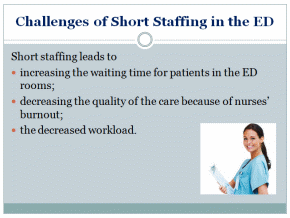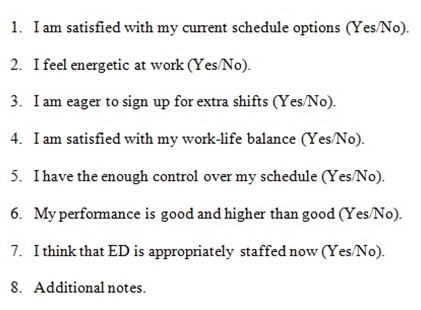The effectiveness of the project implementation and proposed solution for the concrete facility depends on the outcomes of the intervention. In this context, it is important to determine approaches that are appropriate to evaluate the project’s results. Furthermore, it is significant to identify variables relevant to assess the outcomes of the solution.
Methods Used to Evaluate the Effectiveness of the Solution
The solution to the problem of short-staffing in the Emergency Department (ED) is based on integrating the self-scheduling system for the nursing staff in order to guarantee the flexibility in schedules and possibilities to set full day and night shifts without being limited by the overall number of nurses working at the ED during a certain period of time. Therefore, to study the effectiveness of the self-scheduling system to overcome the problem of short staffing, it is necessary to conduct the staff survey and compare the nurse attitudes, perceptions, and experiences regarding the work and life balance, flexibility, job satisfaction, productivity, burnout, and performance before and after the intervention.
It is also important to study how this intervention can influence the aspect of the patient satisfaction; to conduct the survey for patients; and to compare the results of the survey regarding the patients’ visions and perceptions of efficiency of the nurse care in the ED before and after the intervention with the focus on the aspect of satisfaction. The final step is to analyze the results for the short-staffed (before the intervention) and fully-staffed (after the intervention) ED settings based on the overall comparison of findings in their relation to patient satisfaction.
The Variables to Be Assessed
The purpose of three proposed methods for the project evaluation is to study how the intervention strategy can influence changes in such two variables as (1) the nurse staff’s attitudes, perceptions, and experiences and (2) patient satisfaction. In this context, changes in the nurse staff’s attitudes and perceptions are examined in order to conclude about the effectiveness of the solution to resolve the problem of short staffing at the ED. In its turn, the focus on studying the changes in the patient satisfaction is the priority because of the necessity to examine how patients react to changes in the number of nurses available at the ED as a result of the implemented solution. Assessing the changes in patient satisfaction, it will be possible to find how short staffing and full staffing in ED can influence the patients’ perceptions.
Tools Necessary to Educate Project Participants
The materials necessary to educate the nurse staff on the problem of short staffing and aspects of self-scheduling during the training sessions include the PowerPoint presentation and handouts. The slides of the PowerPoint presentation are intended to describe the specific challenges of short staffing in the ED and the impact of short-staffed settings on the patient satisfaction (Appendix A).
In order to educate the nursing staff on the effective use of the self-scheduling tool, it is necessary to provide the personnel with the step-by-step instructions developed for using the integrated online scheduling tool and for making changes in the proposed schedule according to the parameters indicated by Nurse Administrator and within the set timeframe (Appendix B).
Assessment Tools to Evaluate Project Outcomes
The assessment tools that are necessary to evaluate the outcomes of the self-scheduling system implementation are questionnaires for nurses and patients that are provided for the participants of the project before and after the intervention. The questionnaire for nurses is developed to examine the same staff’s perceptions and experiences before and after the intervention in order to assess possible changes in the nurse staff’s experiences and visions of their work and life balance, flexibility, job satisfaction, productivity, burnout, and performance (Appendix C).
The questionnaire for patients is oriented to be divided into two parts, where the first part of the questionnaire is delivered to the patients at the ED before the intervention, when the setting is discussed as short-staffed. The second part of the questionnaire is delivered to the patients at the ED additionally to the first part after the solution is implemented, when the setting can be discussed as full-staffed (number of nurses in shifts is additionally controlled by Nurse Administrator) because of the changes in the approaches to scheduling. The questionnaire results will be used to analyze changes in the patient satisfaction before and after the intervention (Appendix D).
Conclusion
The evaluation of the proposed solution’s effectiveness is a required stage of the project implementation process in order to conclude about the presence or absence of outcomes for the ED staffing and patient satisfaction recorded with the help of the appropriate assessment tools.
Appendix A: Example of the Slide for the Power Point Presentation

Appendix B: Handout for Using the Self-Schedule Tool
- Double-click on Member Entrance.
- Enter the Login information and Password for authorization.
- Double-click on “Schedules” button.
- Click on “Self-Schedule for ED Nurses” button.
- The schedule for the next four weeks will appear. Click on available day or night shifts to sign up for these shifts and add your name and position.
- Click on “Parameters” button to automatically check your workload and number of available shifts.
- Sign up for extra shifts if you wish and your workload is according to parameters “No more than 60 hours in a 7-day period”.
Appendix C: Questionnaire for Nurses

Appendix D: Questionnaire for Patients
